Stone, minerals and semiprecious of the world stone
Carbonate: Malachite
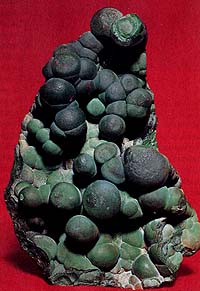 Diagnostic cart.
Diagnostic cart.
On a photo. Concretion bur of the malachite of kidney-shaped reniform structure from Shaby (Zaire).
Cu2 СO3 (OH)2
Crystal structure monoclinic
Hardness on the Mohs scale 4
Specific unit weight mass 4
Cleavage shows up easily
Fracture, break padman
Colors emerald-green
Colors in powder triturate green
Glance (glitter, glare) from waxen-glass to silky
The name is given, probably, for the green colouring, reminding the color of leaves of mallow (Greek. malache is a mallow), or for small hardness of mineral (Greek. malakos - soft). On the ground surface of malachite a pattern is opened from alternating light and dark concentric rings, direct bars or more complicated configuration pattern, conditioned the concentric structure of aggregates. More or less monochromaticity pieces meet rarely.
Malachite a bright green mineral, found in veins and in association with copper deposits. It is a source of copper and is used as an ornamental stone. Composition: hydrated copper carbonate. Formula: Cu2CO3(OH)2. Crystal structure: monoclinic.
In single, very rare cases malachite be found as separate shallow crystals, fasciculate. Usually it forms the microcrystalline aggregates of concretionary, sometimes stalagmitic type. Usually in malachite bodies measuring, mostly, from a few millimetres there are to a few decimetres, is a structure zonal: the bars of fibred-radiant structure alternate, disposed concentric or lamellar, streaky, striate.
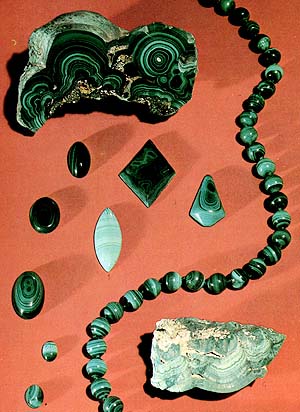 Colors of bars of intensive-green or yellowish-green, sometimes they alternate with blue, related to the presence of Azurite. Glance (glitter, glare) of aggregates can change from waxen-glass to silky at fibred aggregates. Separate fibres are sometimes distinguished with a naked eye.
Colors of bars of intensive-green or yellowish-green, sometimes they alternate with blue, related to the presence of Azurite. Glance (glitter, glare) of aggregates can change from waxen-glass to silky at fibred aggregates. Separate fibres are sometimes distinguished with a naked eye.
Chemical composition (chemistry, compound) is maintenance (in %): CuO - 71,9; CO2-19,9; N2O-8,2. Prismatic type of symmetry. Cleavage - non-existent. Crystals are marked rarely, usually prismatic with verges (100), (110), (010), (201). Twins are developed to on (100). More frequent than all observed as crusts, spherulite, wandering kidney-shaped reniform aggregates radially-radiant, parallel-pole and zonally-concentric structure.
Diagnostic indication.
Malachite not too hard, fragile frail brittle, at a blow falls to pieces; reacts on muriatic acid with the stormy boiling up. Copper (table of contents of which in a mineral more than 70%) condition green colouring and at the contact of powder of mineral with flame paints him in a green color. Fuse melt enough easily. So characteristic type has Ural malachite, that entangling him with malachite, brought from other countries, is impossible. Sometimes malachite forms close accretions with Azurite is азур-malachite, rarer - with turquoise and chrysocolla.
Origin provenance genesis.
Malachite - second mineral, appearing in the area of near-surface oxidization of deposits of copper.
Deposit minefield mine and use.
In the past malachite was obtained on Ural (from there blocks acted weighing to полсотни of tons) and in the mines of Ancient Egypt. Now it is obtained in Australia, Zaire, Zimbabwe, Arizona (USA), Chile, France and Germany. In Italy malachite is marked in Sardinia(Kampo-Pesaro, area of Kalyari), Libiole (an area Liguriya), Karnia and on an island Elba (Kapo-Kalamita). Malachite from ancient times due to the intensively green color and concentric zonality found a wideuse. Now it is used on jeweller business and as very much by a road carpentry stone.
Now the basic supplier of malachite to the world market is Zaire (Kolvezi). Malachite partly processed straight on a place, and partly acts to the market in a raw kind. In addition, the deposits mine of malachite are present in Australia, Chile, Zimbabwe, Namibia, USA (state is Arizona) and CIS (Ural, Kazakhstan).
Application use is on jeweller business.
On jeweller business malachite is used for treatment in form Tondo or oval and cutting in cabochon. Malachite goes also to the dear artistic hand-made articles are small boxes, balls, handles of knives, candelabra etc.
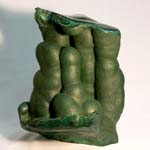
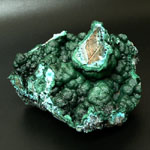
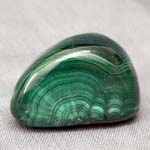
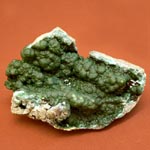
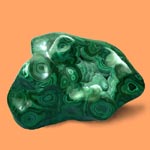
The aggregates of malachite consist of shallow crystals. Large crystals meet very rarely and very valued collectors. Weak glassy brilliance is inherent untilled malachite, but on a fresh fracture and in polishes brilliance for him often silky. Malachite is heat-sensitive and unsteady in relation to acids, ammonia, collapses also in hot water. A mineral is usually presented buds, botryoidal, cone-shaped, by stalactitic-like excretions, rarer - flat crusts. Arises up at affecting of медьсодержащих solutions carbonate rocks in a direct closeness from the deposits of copper and in the area of their oxidization. The most famous deposits of malachite were before on Ural. Exactly malachite was here obtained for revetment of fire-places, table top, wall piers and vases of the Malachite hall of the Winter palace, and also columns of St. Isaac's of Dalmatia Cathedral in City St. Petersburg (Russia, CIS).
In spite of low hardness and unfirmness, malachite and today is one of biggest-selling jeweller and decorative stone. It is polished cabochons or slightly protuberant tablets, from him do beads, and also shallow office decorations are small boxes or supports for candlesticks, clock, ash-trays and small figurines. At treatment of malachite try maximally to expose the decorativeness of stone. "Eyelet" malachite is especially valued with thin concentric rings is a "peacock eye". In large piece of ore, tuff, sinter will not entangle malachite with anything, in shallow wares, where foliation, striation is not visible, it is alike on many opaque green stone.
The problem of receipt preparation of artificial synthetic malachite, suitable for jeweller decorations is presently (including in the CIS) decided; elegant inexpensive beads from such malachite already actively enter sale.
